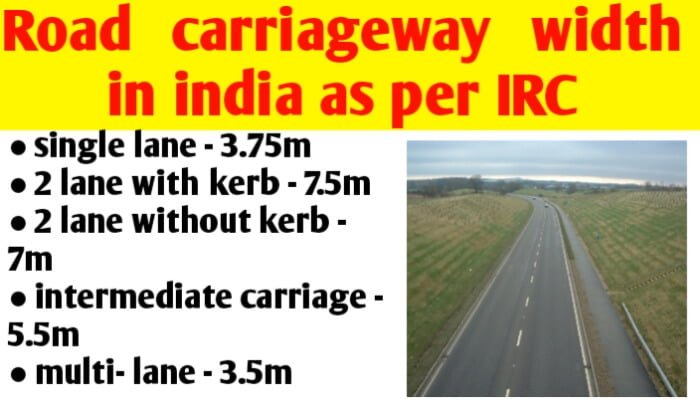The road carriageway width in India can vary based on the type of road and its location. The Indian Road Congress (IRC) provides guidelines for road design, and here are some common carriageway widths according to IRC:-
1. National Highways: Generally, the recommended carriageway width for a four-lane National Highway is around 7 meters per lane. This means that the total carriageway width for a four-lane road would be approximately 28 meters.
2. State Highways: The carriageway width for State Highways can vary but is typically narrower than National Highways, with recommended widths between 5 to 7 meters per lane.
3. Urban Roads: In urban areas, carriageway width can vary widely based on the specific road and local requirements. It can range from around 7 meters for a two-lane road to wider widths for major urban arterials.
There is several kinds of Road in world constructed by central and state government in urban and rural areas, such as National Highway (NH), state highway (SH), MDR (major district road), ODR (other District road) and village road (VR). It will be constructed in plain or mountainous steep & hilly area. Generally National Highway constructed by Central Government of consists of 2 Lane, 3 Lane, 4 lane and 6 Lane Road. State highway, MDR, ODR and village road constructed by State Government consist of single lane, 2 Lane, 3 Lane and 4 lane road.
In india Road construction department have set up Indian Road Congress (IRC). The Indian Roads Congress (IRC) is the Apex Body of Highway Engineers in the country give the guidelines, rule and regulation of several kinds of roads contraction. It is updated several times with new guidelines. In India, all matters related to Geometric design and structure are handle according to to IRC (Indian Road Congress).
A Road/ highway carriageway or a roadway comprises of a built up area of road which uses for travelling traffic over which there is no obstruction with any physical barriers or separation for any vehicle to transit parallel. The width of the carriage way is based on the width of the traffic lane as well as the number of lanes.
Width of the carriage way or the width of the pavement depends on the width of the traffic lane and number of lanes. Width of a traffic lane depends on the width of the vehicles and the side clearance. Side clearance improves operating speed and safety.
The maximum permissible width of a vehicle is 2.44m and desirable side clearance for single Lane traffic is 0.68m at both side to allow crossing and overtaking, so this require minimum of lane width 3.75m for single Lane traffic.
As per IRC the maximum permissible width of a vehicle is 2.44m is allowed and desirable side clearance between two Lane is about 0.53m on both sides and Centre clearance is about 1.06 meter. This require minimum of lane width 3.5m.

Road carriageway width in India as per IRC
In india, as per rules and guidelines of Indian Road Congress (IRC), ideal and standard width of carriageway of road or highway for single Lane traffic should be 3.75m wide for NH, SH, MDR and ODRs, for village road it is kept around 3 metre wide and for 2 lane pavement or road carriageway width shall be 7.5m wide with raised kerbs or 7m without kerbs. It is kept around 3.5m for multi-lane and 5.5m wide for intermediate carriage.
◆You Can Follow me on Facebook and
Subscribe our Youtube Channel
IRC specification for carriage way width
● Single lane – 3.75m wide
● 2 lane without kerb – 7m wide
● 2 lane with raised kerb – 7.5m wide
● multi-lane – 3.5m wide
● intermediate carriage – 5.5m wide
ALSO READ :-
4 lane road width in India as per IRC
2 (two) lane road width in India as per IRC
3 lane road width in India as per IRC
Width of National highway in India as per IRC
Maximum and minimum superelevation in road as per IRC
Now your turns :– if you are happy to see this topics please guys like share and comment and if you have any query and question about this please ask.